May 17, 2025 | 03:12 GMT +7
May 17, 2025 | 03:12 GMT +7
Hotline: 0913.378.918
May 17, 2025 | 03:12 GMT +7
Hotline: 0913.378.918
At the end of 2024, my fellow reporters and I went for a trip to Da Lat, “the city of thousand flowers”. As a natural course of action, we visited Ha Dong craft village - the village of flowers.
Vu Nhuan, currently the head of the flower village, said, “It was 1991. I had just turned 30 years old, and my wife had just given birth to our second child, so our family situation was difficult. There was heavy and prolonged rain in Da Lat that year, so all the flowers in our garden were destroyed by the rain. After many days of thinking and calculating, I decided to try to build a greenhouse to protect my garden from the rain. I had to find books to refer to. The story of building greenhouses had been around for a long time abroad, but not on this land”.
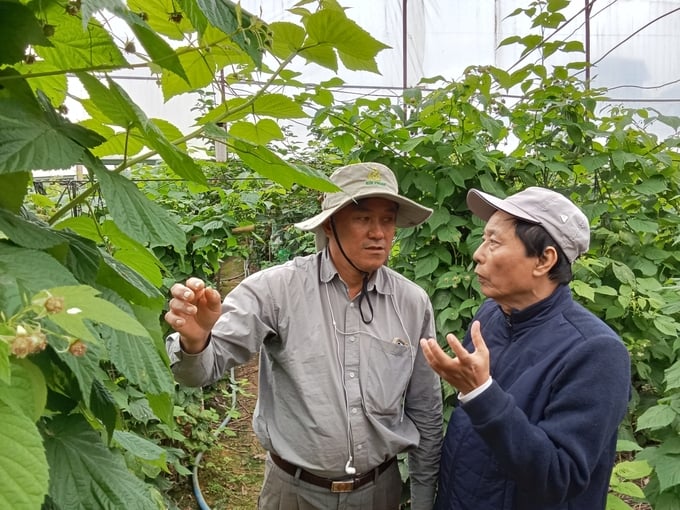
Vu Nhuan (left) shared his stories while checking the greenhouse. Photo: TL.
While listening to Vu Nhuan’s stories, I suddenly remembered the time when the plane was descending to prepare to land at Lien Khuong Airport. Through the plane window, I looked down at Da Lat city appearing behind the misty clouds, a city that in my mind would welcome me with colorful flower fields in full bloom. Instead, my vision was blocked by greenhouses.
No matter how hard I tried, I could only see red tile and green corrugated iron roofs. At that moment, I suddenly felt sad and turned back to my fellow passengers and said: "Maybe now Da Lat should be called a greenhouse city to be closer to reality".
Greenhouses began to develop in Da Lat around 2004. The entire Lam Dong province has over 4,476 ha of greenhouses, of which Da Lat City accounts for more than 57% (approximately 2,550 ha) and 24.32% of the agricultural area of the mountain town.
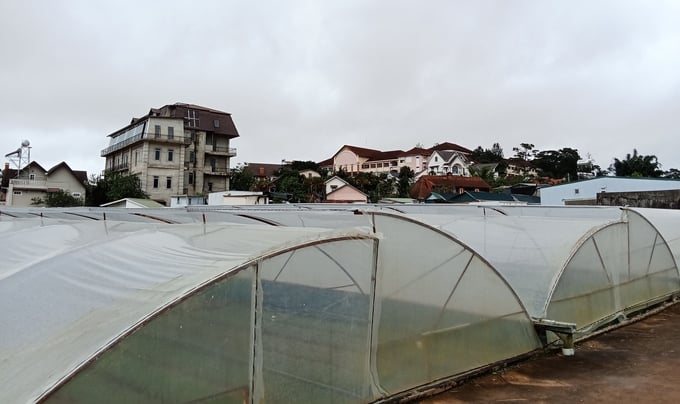
Greenhouses are now everywhere in Da Lat. Photo: Vu Nhuan.
After when Vu Nhuan built a covered garden, Dalat Hasfarm Company, a Dutch enterprise, officially invested in Da Lat in 1994. At that time, Da Lat was still farming in the old way of "looking at the sky, the earth, and the clouds", constantly facing the situation of good harvests and low prices.
The appearance of a Dutch enterprise and a greenhouse flower growing style that did not fear the unpredictable weather created a new source of vitality in agricultural activities. The greenhouses, although small at first, gradually grew larger with the scale of the enterprise's investment.
The flower growing process was shortened by only 2/3 compared to outdoor planting. The risk of crop failure dropped to nearly 0%. It started with the first clusters in the valley along the road of Nguyen Tu Luc, and then greenhouses gradually spread throughout Da Lat and neighboring areas. Wherever vegetables and flowers were grown, there were greenhouses.
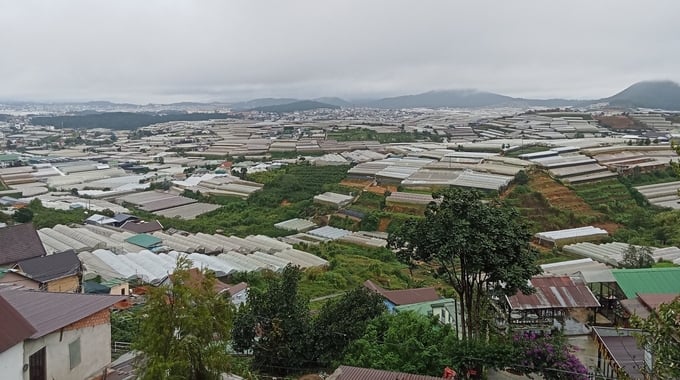
The greenhouse has completely changed the appearance of Da Lat. Photo: Vu Nhuan.
At a glance, greenhouses have brought remarkable results, but information from Lam Dong Department of Agriculture and Rural Development shows that Da Lat city currently has over 10,000 ha of agricultural land, and 54% of which is greenhouses.
That basically means 5,400 ha of land is covered by plastic, not to mention all the encroached areas or greenhouses built without reporting to local authorities. Regardless of the inner city or the suburbs, Da Lat is now full of greenhouses, except for public works and forest land. It feels as if Dalat is being heated by greenhouses.
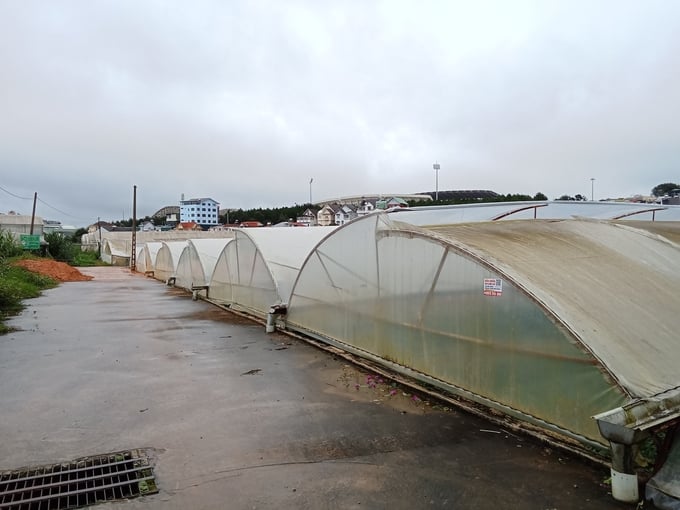
Greenhouses have helped the residents of Da Lat improve their livelihood and living standards, but they also lead to many consequences. Photo: Vu Nhuan.
Under the impact of the heat generated by greenhouses and the monoculture production method (no crop rotation, no rest for soil), the land will degenerate. Fertilizer residues will increase in the soil due to the lack of balancing effects from the natural environment. Fungi will develop more. Water sources will also be polluted. Vegetables and flowers will be more susceptible to diseases than usual. To overcome this, people will be forced to use more fertilizers and pesticides, causing the quality of agricultural products to decline and further polluting the environment.
“Da Lat is very different. This place has a temperate climate for growing vegetables and flowers using high technology without using greenhouses. I have not found any convincing reason that Da Lat must build greenhouses to grow agricultural products, except that farmers and agricultural managers in Da Lat are too eager in their pursuit of output,” said Dr. Lee Hyun Suk (National Institute of Biological Resources of Korea), a scientist conducting research at Lang Biang Biosphere Reserve.
The positive and negative side of using greenhouses is clear. The landscape of Da Lat has disappeared, the proof is that after 18 years I returned to Da Lat, I saw a clear change in terms of climate. Da Lat seems to hold more heat and it rains more. Heavy rains flooding the entire city on the plateau is certainly a very unusual thing. And landslides are also happening more frequently and more seriously.
After hearing Vu Nhuan’s story, I imagine Da Lat city in particular and Lam Dong province in general need to reconsider their priorities after 10 years of greenhouse development. Accordingly, it is crucial to have a mechanism for managing the use of greenhouses by the authorities along with the work of evaluating where to use greenhouses to balance between the interests of farmers and the community.
Agriculture has developed into an industry, which means it will no longer be a spontaneous issue but instead requires careful planning. Lam Dong province needs to assess the issue of greenhouses developing to the point of changing both the appearance and the environment as it is today.
Translated by Samuel Pham
![Multi-channel, multi-directional Vietnamese agricultural markets: [7] Deep processing makes global reach easy](https://t.ex-cdn.com/nongnghiepmoitruong.vn/608w/files/huytd/2025/05/16/2946-che-bien-sau-chia-khoa-vang-nang-tam-nong-san-viet-tren-ban-do-the-gioi-080603_110-093858.jpg)
(VAN) The application of deep processing technology is helping Vietnamese agricultural products enhance their value, create competitive advantages, and open doors to conquer global consumers.
![Multi-channel, multi-directional Vietnamese agricultural markets: [6] Agri products go online](https://t.ex-cdn.com/nongnghiepmoitruong.vn/608w/files/content/2024/12/10/1-113313_954.jpg)
(VAN) Bringing agri products onto e-commerce platforms is an effective way to build a brand that many businesses, cooperatives, and agricultural production households are doing.

(VAN) Veterinary training should focus on quality, not just quantity. Veterinarians also need more options to pursue specialized training.
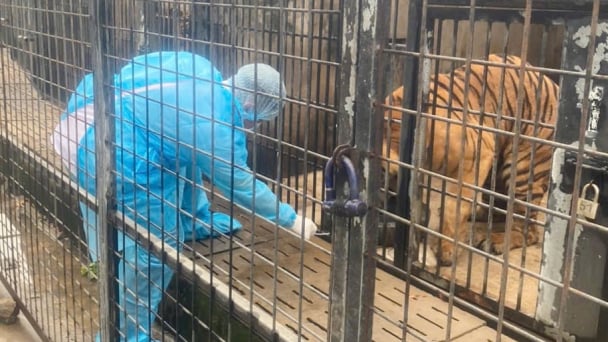
(VAN) The veterinary industry needs to be viewed objectively and further invested in to properly demonstrate its role and importance in the new context.

(VAN) The number of veterinarians graduating each year is not enough to meet actual needs, hence a difficult problem for the growing livestock industry.
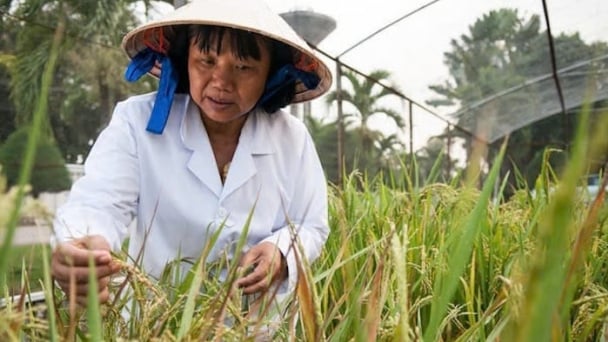
(VAN) The strategic partnership between Cambodia, the Philippines, Vietnam, and CGIAR ensures that innovative solutions effectively address national priorities for food system development.
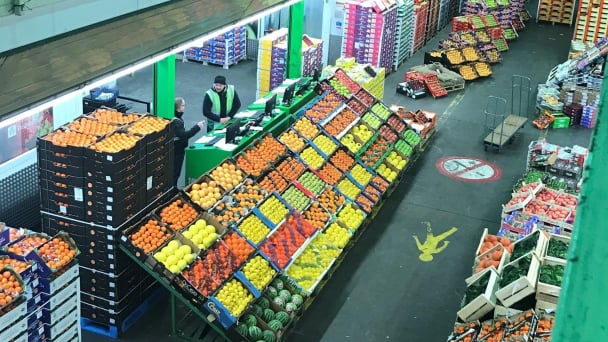
(VAN) This was affirmed by the UK Minister of State at the Department for Environment, Food and Rural Affairs during a working session with Deputy Minister Tran Thanh Nam on May 13.